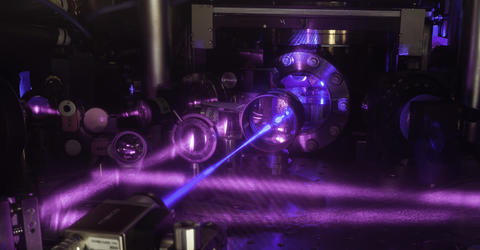A new and improved atomic clock has been created by physicists at the Joint Institute for Laboratory Astrophysics (JILA). It is the most accurate clock in the world-- after two hours, it had an error of 3.5 in ten quintillion (or 3.5 in 10,000,000,000,000,000,000).
Atomic clocks use an electrons ability to switch between energy states to operate. When the electrons are exposed to specific frequencies of radiation (like radio waves), they change states. Scientifically speaking, the a second is defined as "9,192,631,770 cycles of the radiation that gets an atom of the element called cesium to vibrate between to energy states." Atomic clocks work by funneling atoms down a tube, passing through radio waves at the correct frequency (9,192,631,770 cycles per second) to get the atoms to shift energy states, and the shifted atoms are tracked by a detector at the end of the tube. The generator that produces the radio waves receives information from the detector to synchronize the frequency of the radio waves. When the frequency is achieved, a second is marked.
The intense accuracy of the clock will be useful for making future experiments and tests even more exact. Past experiments can be revisited to see if the newfound accuracy will yield different results. The investigation to finding dark matter could also benefit from the near-perfection the clock attains.
The new atomic clock is the first of its kind, allotting plenty of room for refinement. What else could this technology be used for in future times? Can the design of the atomic clock be improved in another groundbreaking way? How will scientists make it even more precise? Only the future will tell.
 |
| Pictured: the upper table of the 3-D quantum gas atomic clock |
Atomic clocks use an electrons ability to switch between energy states to operate. When the electrons are exposed to specific frequencies of radiation (like radio waves), they change states. Scientifically speaking, the a second is defined as "9,192,631,770 cycles of the radiation that gets an atom of the element called cesium to vibrate between to energy states." Atomic clocks work by funneling atoms down a tube, passing through radio waves at the correct frequency (9,192,631,770 cycles per second) to get the atoms to shift energy states, and the shifted atoms are tracked by a detector at the end of the tube. The generator that produces the radio waves receives information from the detector to synchronize the frequency of the radio waves. When the frequency is achieved, a second is marked.
Now, back to the matter at hand.
The previous design of the atomic had electrons waiting to be funneled kept in one-dimensional, "pancake-shaped" clouds of gas. The electrons could collide and bump into each other, disrupting the rhythm, thus producing less accurate results. The new atomic clock arranges electrons in a 3-D cube that is 1,000 times more dense than the one-dimensional pancake. The design uses the behavior of quantum gas, instead of the previous use of thermal gas, to be so precise. Quantum gas restricts particles' properties so they cannot hit other particles. The immobilized unit of particles, known as a "quantum many-body system," tick seconds as a unit, instead of ticking seconds individually as it used to be done. The particles are controlled and stable, allowing for higher precision.
 |
| Pictured: a graphic of the cube of electrons in the new atomic clock |
The intense accuracy of the clock will be useful for making future experiments and tests even more exact. Past experiments can be revisited to see if the newfound accuracy will yield different results. The investigation to finding dark matter could also benefit from the near-perfection the clock attains.
The new atomic clock is the first of its kind, allotting plenty of room for refinement. What else could this technology be used for in future times? Can the design of the atomic clock be improved in another groundbreaking way? How will scientists make it even more precise? Only the future will tell.
Comments
Post a Comment